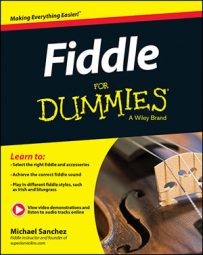With so many things to think about when playing the fiddle, how do you know whether you're practicing everything the right way? The following checklist will put you on the right path. It's split into six sections and includes the purpose of each technique.
There are 30 techniques here, so it's important for you to focus on only one section at a time. Take a simple piece (like "Mary Had a Little Lamb") and work on these points.
Good posture leads to good technique
A straight back promotes a straighter bow.
Using a shoulder rest leads to good holding habits.
A proper fiddle level promotes better tone and bow straightness.
Holding the fiddle at a 45-degree angle (more in front) helps you get to the tip of the bow.
Good instrument setup leads to great tone
Having your fiddle in tune helps achieve good intonation.
A properly tightened bow helps you get the best tone and avoid bow bounce.
Having enough rosin on the bow helps avoid bow wispiness.
Good left-hand technique leads to great melodies
Keeping your knuckles up helps intonation and your ability to play fast.
Keeping your finger angles back helps you find notes efficiently.
Using your fingertips leads to good finger contact and solid note tones.
Keeping your hand still and only moving your fingers promotes finger speed/efficiency.
Keeping your fingers curved and close to the fingerboard helps you find notes quickly.
Hitting half steps/whole steps helps you play more in tune.
Good right-hand technique leads to a clean sound
Having your thumb curved in the groove helps restrict tension up against the bow.
Having your pinkie curved on the button helps restrict tension up against the bow.
Keeping your bow hand fingers on an angle helps you apply proper index finger pressure.
A loose grip helps restrict tension up against the bow.
Having your index finger over the stick helps you produce a clean sound.
Keeping your knuckles on top of the stick helps to keep your hand relaxed.
Using your index finger helps to phrase passages cleanly and musically.
Good right-arm technique allows your index finger to speak
A relaxed shoulder helps prevent bow bounce.
An extended arm allows your smaller muscles to transition the bow.
Adjusting your wrist and keeping it level helps prevent bow squeaks.
Minimal arm movement allows you to get a cleaner sound when playing fast.
Pivoting your elbow to the E, A, D, or G location helps keep the bow straight across the strings.
Good bow technique allows your index finger to speak
A consistent bow speed helps prevent bow squeaks and improper tone.
Lightly using your index finger when changing bow directions allows you to get a clean and smooth sound.
Getting to the tip helps you get a full and clean sound on the fiddle.
Keeping bow hairs evenly on the strings helps you get the best tone out of your fiddle.
Keeping your bow grip relaxed while going toward the tip helps you get a better transition sound.
Don't get overwhelmed by everything on this checklist. As you progress, you'll find that this checklist will continue to help you, even when you have more experience. As songs get harder, you'll notice that some of these things are harder to do, even if you've mastered them with simple songs such as "Mary Had a Little Lamb."
Try to become comfortable with at least 75 percent of these techniques (with one song) and then move on. Don't feel like you have to get everything perfect; moving forward and learning new material is just as important as dwelling on one thing. If you practice "Mary Had a Little Lamb" forever, you won't be good at anything other than that one song.

